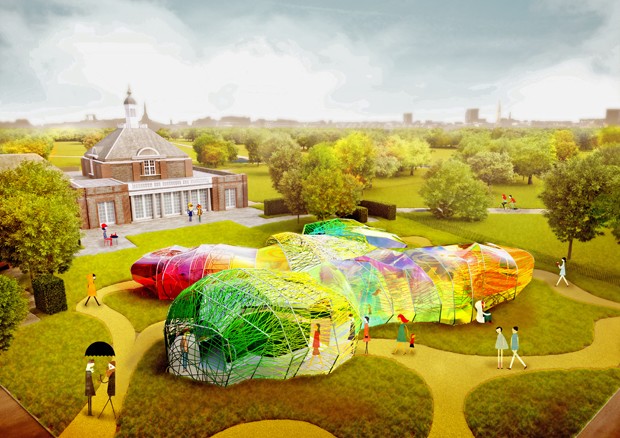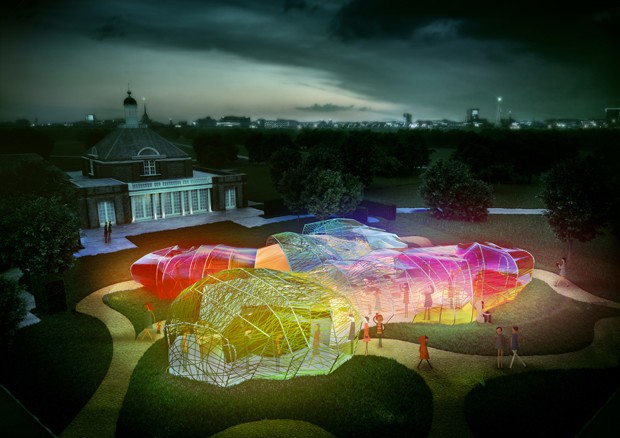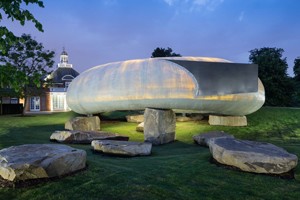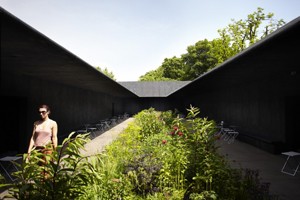London’s Serpentine Galleries has revealed designs for its 15th annual pavilion, with renders showing an amorphous, double-skinned polygonal structure consisting of panels of a multi-coloured fabric membrane woven through and wrapped in webbing.
According to designers Madrid-based architects SelgasCano, the design was borne of “pure visitor experience”, and founded on ideas about what the structure needed to provide, what materials should be used in a Royal Park in London, and how to connect the pavilion with nature so that it sat as a part of the landscape.

Above: Artist impression of the Pavilion in the day.
“We sought a way to allow the public to experience architecture through simple elements: structure, light, transparency, shadows, lightness, form, sensitivity, change, surprise, colour and materials. We have therefore designed a Pavilion which incorporates all of these elements,” the architects describe.
“The spatial qualities of the Pavilion only unfold when accessing the structure and being immersed within it. Each entrance allows for a specific journey through the space, characterised by colour, light and irregular shapes with surprising volumes.
“This is accomplished by creating a double-layered shell, made of opaque and translucent fluorine-based plastic (ETFE) in a variety of colours. At the heart of the Pavilion is an open space for gathering as well as a café.”
Visitors will be able to enter and exit the Pavilion at a number of different points, passing through a ‘secret corridor’ between the outer and inner layer of the structure, and into the stained glass-effect interiors.
“We are also very much aware of the Pavilion’s anniversary in our design for the 15th annual commission,” SelgasCano adds. “The structure therefore had to be – without resembling previous Pavilions – a tribute to them all and a homage to all the stories told within those designs.”

View of the Pavilion at night. Images: Steven Kevin Howson / SelgasCano
Since its inception in 2000, Pavilions have been designed by renowned architects Rem Koolhaas, Frank Gehry, Jean Nouvel, Zaha Hadid, and Oscar Niemeyer, and range from SANAA’s floating aluminium cloud in 2009, to Peter Zumthor’s zen-like garden enclosure in 2011, and Smiljan Radić’s shell-like structure in 2014.


Left: 2014 Pavilion by Smiljan Radić. Right: 2011 Pavilion by Peter Zumthor. Source: Serpentine Galleries
In keeping with the criteria of the commission, the Pavilion will be the first built structure in England by SelgasCano.
“We are proud to work with SelgasCano in this, the 15th year of a commission unique in the western world that continues to showcase some of the boldest and innovative designs in contemporary architecture internationally,” said Serpentine Galleries Director, Julia Peyton-Jones and Co-Director, Hans Ulrich Obrist.
“In keeping with their reputation for playful designs and bold use of colour, SelgasCano’s structure will be an extraordinary chrysalis-like structure, as organic as the surrounding gardens. We can’t wait to go inside to experience the light diffused through the coloured panels like stained glass windows. It will be a place for people to meet, to have coffee and to experience the live events we put on throughout the summer.”
The Pavilion will stage the Serpentine’s Park Nights every Friday night between July and September, with events that bring together art, poetry, music, film, literature and theory. This year’s program will include three new commissions by artists Jesse Darling, Fleur Melbourn and Marianna Simnett.

